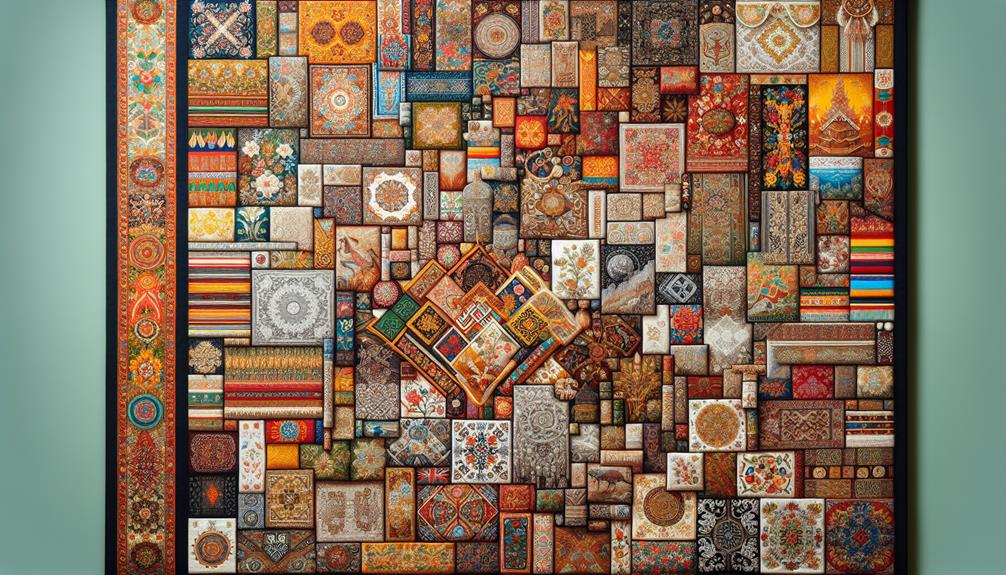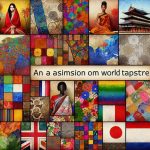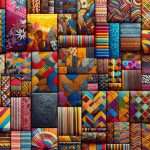Imagine attending a traditional Japanese tea ceremony where participants wear intricately woven kimonos, each fabric telling a story of its own. You start to notice how these textiles aren't just garments but symbols of history and identity. They hold meanings that go beyond their aesthetic appeal, reflecting the wearer's social status, family heritage, and even regional origin. This pattern of using fabrics to convey cultural narratives is not unique to Japan; it's a global phenomenon. So, how do these threads of tradition weave into the broader tapestry of cultural identity?
Table of Contents
Key Takeaways
- Fabrics symbolize cultural beliefs and social structures through colors and patterns.
- Textiles are integral to ceremonies such as weddings and religious rites, symbolizing different life stages.
- Regional textile techniques reflect local cultures, like Japan's natural fibers and Mexico's weaving methods.
- Indigenous weaving and dyeing methods preserve cultural identity and eco-friendly practices.
- Modern adaptations of traditional fabrics blend heritage with contemporary fashion and decor.
Historical Significance
Throughout history, fabrics have played an essential role in shaping cultural identities and traditions. You'll find that the cultural significance of textiles is immense, as they've evolved alongside human societies. From the earliest handwoven cloths to the intricate designs of modern times, textiles reflect the values and advancements of different civilizations.
Consider the evolution of textiles in ancient Egypt. Linen, made from flax, wasn't just a fabric; it was a symbol of purity and status. The Egyptians mastered flax weaving, creating garments that have been preserved for thousands of years. Similarly, in China, silk cultivation and weaving became an art form, influencing trade and diplomacy on a global scale.
You can trace textile evolution through the diverse methods and materials used by various cultures. In India, the vibrant hues and complex patterns of hand-loomed fabrics like sari and pashmina shawls tell stories of regional heritage and artisanal skill. The intricate designs and techniques employed reflect a cultural significance that goes beyond mere aesthetics.
Symbolism in Textiles
Textiles often carry profound symbolic meanings, revealing much about a culture's beliefs, values, and social structures. When you explore the intricate patterns and colors of a culture's textile traditions, you're not just appreciating artistic expressions; you're uncovering layers of cultural significance. Each motif and hue can tell stories of ancestry, spirituality, and social hierarchies.
In many cultures, the use of specific textiles is deeply intertwined with social importance. For instance, in West African societies, Kente cloth isn't just a vibrant fabric; it's a symbol of royalty and communal identity. The patterns and colors used in these textiles convey messages about the wearer's status and lineage, acting as a living proof to their heritage.
Moreover, the artistic expressions found in textiles often serve as a medium for preserving history and conveying moral lessons. For example, the intricate embroidery of Eastern European garments encapsulates tales of folklore, embodying the wisdom passed down through generations.
Ceremonial Uses
In many cultures, fabrics play an essential role in ceremonies, marking significant life events and communal celebrations. You'll find that these textiles aren't just materials; they're woven with layers of fabric symbolism and cultural significance. Whether it's weddings, funerals, or religious rites, the choice of ceremonial clothing is meticulously made, reflecting the deep-rooted textile traditions of a community.
Consider the following key aspects of ceremonial uses of fabrics:
| Event Type | Fabric Symbolism and Cultural Significance |
|---|---|
| Weddings | Silk for purity, red for prosperity |
| Funerals | White for mourning in some cultures, black in others |
| Religious Rites | Linen for sanctity, saffron for spirituality |
| Festivals | Cotton for comfort, vibrant colors for joy |
Regional Variations
When you explore regional variations in fabrics, you notice unique traditional textile techniques specific to each area.
You'll find symbolic fabric patterns that reflect local culture and beliefs.
Additionally, regions often use material sources that are native to their environment, adding another layer of uniqueness.
Traditional Textile Techniques
You'll find that traditional textile techniques showcase fascinating regional variations, each with its unique methods and cultural significance. Across the globe, artisans employ diverse practices that not only highlight their heritage but also reflect a commitment to sustainability.
- Natural Fibers: Regions like India and Peru emphasize the use of natural fibers such as cotton, wool, and silk. These materials aren't only eco-friendly but also durable, promoting sustainability within local communities.
- Weaving Techniques: In Japan, the intricate art of Kasuri involves dyeing threads before weaving, creating stunning patterns. Meanwhile, in Mexico, the backstrap loom technique passed down through generations, preserves cultural heritage while adapting to modern demands.
- Dyeing Methods: Indonesia's Batik and Nigeria's Adire both utilize wax-resist dyeing methods, each with distinct styles that celebrate regional identity. These methods have been modernized to meet contemporary tastes without losing their traditional essence.
- Embroidery Styles: Eastern European countries like Ukraine and Romania are renowned for their elaborate embroidery, which often tells stories and symbolizes regional pride. The modernization of these techniques guarantees their continuation and relevance in today's fashion industry.
Symbolic Fabric Patterns
Exploring symbolic fabric designs reveals how deeply cultural meanings are woven into textiles, reflecting regional identities just as traditional textile techniques do. When you examine these patterns, you'll discover that each design element serves as a form of artistic expression and a marker of cultural identity. In many regions, local folklore and traditions are encoded into the intricate designs, making each piece not just a fabric but a narrative.
Think about color symbolism: in some cultures, red might signify power and essentiality, while in others, it could represent love and passion. Similarly, pattern meanings vary widely. For instance, geometric shapes might be prevalent in one area, symbolizing harmony and order, while floral patterns in another region might indicate growth and prosperity. By understanding these nuances, you can appreciate how these textiles serve as a visual language that communicates deeply held values and beliefs.
As you explore further into the world of symbolic fabric patterns, you'll see how these elements preserve history and foster a sense of belonging. Patterns aren't just decorative; they're a profound way for cultures to express their unique identities and artistic sensibilities.
Regional Material Sources
In different regions, the materials used for fabric production vary widely based on local resources and environmental conditions. Understanding this diversity is essential for grasping the fabric's cultural significance and environmental impact.
Let's explore how regional sources influence fabric production:
- Natural Fibers: In areas rich with cotton, like Egypt and India, you'll find fabrics that are environmentally sustainable and economically essential. Cotton production supports local economies while preserving cultural weaving techniques.
- Animal Fibers: In cold climates, such as Mongolia, the use of wool and cashmere from local herds is prevalent. These materials offer warmth and durability, ensuring economic sustainability and maintaining traditional herding practices.
- Plant-Based Fibers: Southeast Asia utilizes bamboo and jute, which grow abundantly due to the humid climate. These fibers are eco-friendly and support local artisans, promoting cultural preservation through traditional crafting methods.
- Synthetic Fibers: In industrialized regions, synthetic materials like polyester are common. While less sustainable, they reflect a shift towards mass production, impacting both cultural practices and the environment.
Artistry and Craftsmanship
You'll find that traditional weaving techniques, embroidery, and dyeing methods all tell stories of their own. Each practice reflects unique cultural symbolism and historical significance.
Traditional Weaving Techniques
Mastering traditional weaving techniques involves a delicate balance of artistry and craftsmanship that has been passed down through generations. To truly appreciate this craft, you must understand the intrinsic value of indigenous techniques and their role in cultural preservation. These techniques aren't just about creating fabric; they're about sustaining a connection to your heritage and community.
Here's what you'll need to explore:
- Indigenous Techniques: Learn the unique methods developed by various cultures, like the Ikat weaving of Indonesia or the Navajo weaving of North America. Each technique tells a story and maintains cultural identity.
- Handloom Skills: Master the use of the handloom, an essential tool in many traditional weaving practices. This skill emphasizes precision and patience, ensuring that every thread contributes to a cohesive and beautiful pattern.
- Sustainable Practices: Focus on the eco-friendly aspects of traditional weaving. Many indigenous methods utilize natural dyes and locally-sourced materials, making them sustainable and environmentally conscious.
- Artistry and Craftsmanship: Appreciate the artistic elements within weaving. The intricate designs and vibrant colors aren't just aesthetic choices but are imbued with cultural significance and storytelling.
Embroidery and Symbolism
Embroidery's intricate patterns and vibrant hues serve as a visual language, weaving stories and cultural symbols into every stitch. As you explore the world of embroidery, you'll find that each stitch pattern holds a depth of traditional meanings. The artistry involved isn't just in the needlework but in the understanding of these patterns and their cultural significance.
When examining color symbolism, you'll notice that each hue carries its own weight of meaning. For instance, red often signifies passion or power, while blue might represent tranquility or protection. These colors aren't randomly chosen; they're meticulously selected to convey specific messages and emotions, deeply rooted in cultural contexts.
Stitch patterns, like the chain stitch or satin stitch, are more than just techniques; they're repositories of history and tradition. Each pattern tells a story, whether it's a representation of nature, a tribute to ancestors, or a symbol of spiritual beliefs. By mastering these stitches, you're not just learning a craft, you're embracing a culture and preserving its heritage.
In essence, embroidery is a fusion of artistry and craftsmanship, where every thread and color choice speaks volumes about the cultural significance embedded in the fabric.
Dyeing Methods History
Just as embroidery tells stories through thread, the art of dyeing fabrics has its own rich history of transforming plain textiles into vibrant cultural artifacts.
You'll find that mastering dyeing methods involves understanding not just the techniques but also the natural dyes and their cultural significance. These dyes, sourced from plants, minerals, and even insects, have been essential in creating colors that tell stories of heritage and identity.
To appreciate the artistry and craftsmanship involved, consider these key historical dyeing methods:
- Tie-Dye: Originating in ancient India and Japan, this method involves binding fabric to create patterns. The cultural significance lies in its use during festivals and spiritual ceremonies.
- Batik: A wax-resist dyeing technique from Indonesia, batik's intricate designs often symbolize social status and community belonging.
- Indigo Dyeing: Used widely in Africa and Asia, indigo dyeing involves a deep blue dye from the indigo plant, symbolizing wealth and nobility.
- Madder Root Dye: This red dye, used in Europe and Asia, has been associated with power and protection in various cultures.
Each method reflects a deep connection between fabric and the stories woven into the cultural fabric of societies. Mastering these techniques means preserving a piece of history through artistry and craftsmanship.
Modern Adaptations
Contemporary designers have skillfully reimagined traditional fabrics, blending them seamlessly into modern fashion and home decor. Through contemporary interpretations and cultural fusion, they've managed to create pieces that honor historical roots while appealing to today's aesthetic sensibilities. You can see this in collections that mix ikat patterns with minimalist designs or pair vibrant African prints with sleek silhouettes.
Modern adaptations often incorporate global influences and textile innovation. For instance, Japanese kimonos inspire modern-day wraps and jackets, while the intricate embroidery of Indian saris finds its way onto chic dresses and blouses. Advanced technologies like digital printing and sustainable fabrics have further revolutionized how these traditional elements are used, making them more functional and environmentally friendly.
Here's a snapshot of how traditional fabrics are being adapted today:
| Traditional Fabric | Modern Application |
|---|---|
| Ikat | Minimalist home decor |
| African Prints | Contemporary fashion pieces |
| Japanese Kimono | Modern wraps and jackets |
| Indian Sari | Chic dresses and blouses |
Preserving Heritage
Preserving heritage involves maintaining the intricate craftsmanship and cultural significance of traditional fabrics for future generations. You play a significant role in cultural preservation by understanding and engaging in textile conservation.
To keep these traditions alive, you need to focus on several key aspects:
- Documentation: Record the techniques and stories behind traditional craftsmanship. This helps make sure that the knowledge isn't lost over time.
- Education: Teach newer generations about the importance of heritage protection. Workshops and courses can promote a deeper appreciation and skill development.
- Restoration: Engage in the careful restoration of aged textiles. This process not only safeguards the fabrics but also keeps the craftsmanship visible and tangible.
- Support: Back artisans and communities that continue traditional practices. Your support can provide the resources needed for sustaining these arts.
Frequently Asked Questions
How Are Traditional Fabrics Typically Cleaned and Maintained?
You should hand wash traditional fabrics to maintain preservation. Use gentle detergents to sustain dye techniques. Perform repairs promptly to prevent further damage. This meticulous care helps in maintaining the fabric's integrity and appearance.
What Are the Environmental Impacts of Producing Cultural Textiles?
Imagine a world where every thread is a footprint. You've got to champion eco-friendly practices and sustainability initiatives to mitigate the environmental impacts of producing textiles. Each choice weaves a greener future.
Are There Any Health Benefits Associated With Wearing Natural Fabrics?
You'll find that natural fabric benefits your wellness by promoting better comfort. Wearing natural fabrics like cotton or linen helps regulate your body temperature and reduces skin irritations, contributing to overall health and well-being.
How Do Modern Fashion Trends Influence Traditional Fabric Designs?
How can you resist the allure of global influences on traditional fabrics? Modern fashion trends drive fabric innovation, blending old and new. While cultural appropriation is a concern, textile preservation guarantees cultural heritage remains intact.
What Are the Economic Implications for Communities Producing Cultural Textiles?
You'll find that producing cultural textiles drives economic empowerment and cultural preservation. It fosters sustainable livelihoods and community development, ensuring these communities thrive and maintain their unique heritage while benefiting economically.
- Recycling Nonwoven Fabrics: Is It Possible? - July 11, 2025
- Recycling Nonwoven Fabrics: Is It Possible? - July 11, 2025
- Recycling Nonwoven Fabrics: Is It Possible? - July 11, 2025






